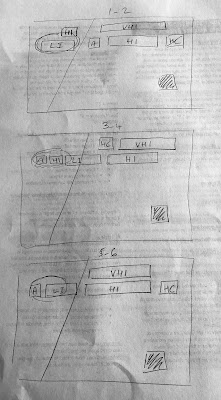This post was going to be a short post about the order of battle and deployment of units on the tabletop for a game and battle report. The game has been played and I have been a tad slow in posting it. However, in the process of writing the post I have added some notes mapping out where player decision points occur in the One Hour War-games (OHW) rule variant being used.
 |
| A Roman commander painted and in a game. I always know when a project is just about done when I paint the commanders. |
Order of Battle
I have yet to decide how to determine the order of battle for a series of campaign games. At the moment for one-off games I am using the army list suggestions from the book Ancient and Medieval Wargaming by Neil Thomas as a guide.
 |
| Both forces are now deployed and ready for a game. |
For the upcoming battle report I opted for the following orders of battle:
Carthaginian (10 units)
- 2 x Elephants
- 2 x Veteran Heavy Infantry
- 2 x Heavy Infantry
- 2 x Light Infantry
- 1 x Light Cavalry
- 1 x Heavy Cavalry
- 3 x Veteran Heavy Infantry
- 3 x Heavy Infantry
- 2 x Light Infantry
- 1 x Artillery
- 1 x Heavy Cavalry
Deployment
Having decided upon the order of battle, the next step is deciding each army's deployment. Both sides decide their deployment in secret by drawing the deployment on a sketch of the tabletop. All forces are then deployed within 18 inches of the tabletop edge (on a 6 x 4 foot tabletop) according to the sketches.
Because I am playing solo and will be taking the role of the Carthaginian player. I deployed the Carthaginian forces first. I then sketched three deployments for the Roman army. Rolling the dice to decide which option to deploy on the tabletop. I rolled a 2, the top sketch.
 |
| Three Roman deployment options sketched out. |
The battle report will hopefully be my next post.
Decision Points
As a little exercise I thought I would list all the decision points a player has in preparing and playing a game. Why do this? There are a couple of reasons:
- The decisioning around the deployment of forces seems to have been really important in the outcome of battles. As deployed forces were generally difficult to reposition during the battle. In the One-Hour Wargames (OHW) rules I am using I have increased the unit base size to 8 inches which makes turning difficult unless there is sufficient space.
- As forces become committed to combat the opportunity to make decisions is reduced as reserves or battle lines are committed.
- Terrain layout rules and how a player can influence the layout of the limited terrain.
- How to add a commander rule into the game rules to influence combat. (Especially now as I have painted up both commanders for this project.)
- How to add some decisions into chance cards. An initial thought, for example, is to change Rally cards from removing 2 hits from all units with hits, to removing 2 hits from a maximum of 4 units. Then a player would have to decide which units.
 |
| Carthaginian Commander. A mixed unit so it can attach to either a heavy cavalry unit of heavy infantry unit. |
Perhaps a Rally card should rally 2 points off the 4 units nearest the commander, or possible within a given distance (would allow an element of commander quality / charisma)? You would then have to decide where your commander should go to influence units - if you're the commander I don't see how you can decide to rally a unit on the opposite side of the battlefield that you would be unaware of.
ReplyDeleteA few options and combinations there to consider as I add and try out rules for the commanders. Thanks.
DeleteVery interesting! I'm currently playtesting a hoplite warfare OHW variant and your posts are a great source of inspiration.
ReplyDeleteRegarding your last two points (role of commanders and add a decision point to rally), maybe you could simply merge both into one? For example, rally cards might only work for units within a given distance from a commander. Two birds, one stone :-)
I look froward to reading about your progress with a hoplite OHW variant. I will certainly be trying the option to rally off hits within range of the commander. Thanks.
DeleteInteresting analysis Peter. Is the idea to foster decision points throughout the game so they don’t tail off so much?
ReplyDeleteI like the way player decisions generally diminish as the game progresses. I did the exercise to help get it clear in my mind where the decisioning is occurring. In some ways I actually want to add more decisions when setting up the game, rather than later on in the game.
DeleteThis is an interesting observation. Should decision points be monotonically decreasing throughout the game? Hmm. I need to think on this too.
DeleteMy initial thinking is options should be decreasing as the game progresses, and the way to counter this is through the careful commitment of reserves. (Not that I have ever been that successful with my reserves.)
DeleteFrom a historical perspective decision making at the top level should drop off as the battle advances. From a gaming point of view it might be less fun.
Delete